Hi everyone!
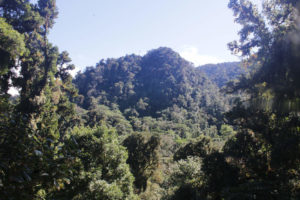 Today was our second day in the Cloud Forest. We woke up and made our breakfast of eggs and pancakes. The plan for the day was to meet for a group hike that was originally described by our guide Abel as “extremo pero vale la pena.” We made it to the trail head of el Sendero Millenio meeting the other cabin members at 8:30. At the start of the trail, Abel told us that we would
Today was our second day in the Cloud Forest. We woke up and made our breakfast of eggs and pancakes. The plan for the day was to meet for a group hike that was originally described by our guide Abel as “extremo pero vale la pena.” We made it to the trail head of el Sendero Millenio meeting the other cabin members at 8:30. At the start of the trail, Abel told us that we would 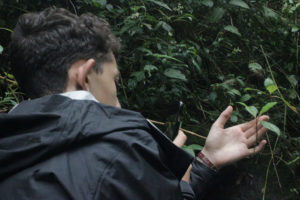 have about a half an hour of steep climbing until we reached the peak where the trail evened out. After the steep and muddy start to the hike, we made it to the top where a view of the surrounding cloud forest was visible. We then descended into meadows agricultural fields with great view of the valley below. After completing the hike, we made it back just in time for lunch which was prepared by our chef Señora Ramira. We had some soup and fried plantains before
have about a half an hour of steep climbing until we reached the peak where the trail evened out. After the steep and muddy start to the hike, we made it to the top where a view of the surrounding cloud forest was visible. We then descended into meadows agricultural fields with great view of the valley below. After completing the hike, we made it back just in time for lunch which was prepared by our chef Señora Ramira. We had some soup and fried plantains before 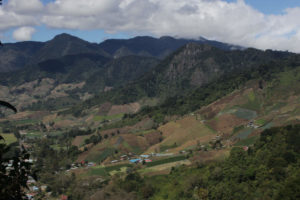 heading out for our second activity of the day. After lunch, we met with two researchers who are staying in a cabin here and they shared information about their research and camera traps on an Barro Colorado Island, in Lake Gatún (the large freshwater lake in the middle of the Panama Canal). We saw many photos of mammals (especially species of cats) from their camera traps and learned about their behavior and issues of regarding their conservation. Our second activity was dedicated to our individual projects here. Isaac and my project is to study and create a series of film of underwater activity or creatures in a near by set of waterfalls. We got caught up on setting up our GoPro equipment and only ended up getting to walk around near our cabin.
heading out for our second activity of the day. After lunch, we met with two researchers who are staying in a cabin here and they shared information about their research and camera traps on an Barro Colorado Island, in Lake Gatún (the large freshwater lake in the middle of the Panama Canal). We saw many photos of mammals (especially species of cats) from their camera traps and learned about their behavior and issues of regarding their conservation. Our second activity was dedicated to our individual projects here. Isaac and my project is to study and create a series of film of underwater activity or creatures in a near by set of waterfalls. We got caught up on setting up our GoPro equipment and only ended up getting to walk around near our cabin.
– Lucas
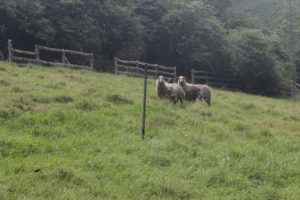 As soon as everyone returned from their respective projects, we met inside the cabin for dinner. Señora Ramira had prepared a dinner of fresh vegetables and pork for us to eat. She also brewed a pot of tea using a local herb and honey for sweetener. It was one of the best cups of tea I had ever had, so I had three cups of it. After dinner we arranged chairs and the furniture in a circle so that we could have a discussion (all in Spanish) with our guide Abel, Mitzy, our Panamanian course leader, and our wonderful chef Señora Ramira. We were able to ask questions about anything that we had an interest in, and this was also used as an opportunity for some people to learn more about each others individual projects. One of the first questions asked was about the pros and cons of tourism in Panama. Abel began by saying
As soon as everyone returned from their respective projects, we met inside the cabin for dinner. Señora Ramira had prepared a dinner of fresh vegetables and pork for us to eat. She also brewed a pot of tea using a local herb and honey for sweetener. It was one of the best cups of tea I had ever had, so I had three cups of it. After dinner we arranged chairs and the furniture in a circle so that we could have a discussion (all in Spanish) with our guide Abel, Mitzy, our Panamanian course leader, and our wonderful chef Señora Ramira. We were able to ask questions about anything that we had an interest in, and this was also used as an opportunity for some people to learn more about each others individual projects. One of the first questions asked was about the pros and cons of tourism in Panama. Abel began by saying 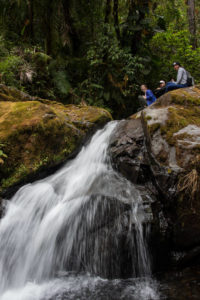 that there are two types of tourists, those that are from Panama and those that are from Europe and America. He said that those from Europe and America were more willing to explore and learn more about the country than the Panamanians themselves. Mitzy then joined in answering the question to talk about tourists and tourist businesses. She talked about how the businesses that are created for tourists in Panama are not created by Panamanians, but rather by foreigners. She said that the businesses exploit the tourists by overpricing everything, and many of the tourists in the province where she lived we’re just backpackers or people looking for work. Related to this there was also discussion of the businesses that control the energy industry within Panama. We learned that the hydroelectric plants in Panama are generally owned by foreigners and large international companies that sell the energy that the produce to the government of Panama, and to Costa Rica as well. They said that as a consequence of selling the once nationalized industries to international companies the prices of energy and cell service all were raised. Foreign companies also make under the table deals with the Panamanian government to get special treatment in regards to labor regulation and environmental regulation. Señora Ramira explained that this is because the people are ignorant and that they are the ones who must change if they want the system to change. There is a lot of political apathy jn Panama because people feel that things cannot change. Abel’s perspective is that it is not the people’s fault, but rather the government. It is the government that signs the deals and does the wrong thing repeatedly just for money. The discussion ended with debate over whether the people or the government are to blame for the problems that exist in Panama today. It was a unique and special experience that helped give all of us a new perspective on the country we are visiting.
that there are two types of tourists, those that are from Panama and those that are from Europe and America. He said that those from Europe and America were more willing to explore and learn more about the country than the Panamanians themselves. Mitzy then joined in answering the question to talk about tourists and tourist businesses. She talked about how the businesses that are created for tourists in Panama are not created by Panamanians, but rather by foreigners. She said that the businesses exploit the tourists by overpricing everything, and many of the tourists in the province where she lived we’re just backpackers or people looking for work. Related to this there was also discussion of the businesses that control the energy industry within Panama. We learned that the hydroelectric plants in Panama are generally owned by foreigners and large international companies that sell the energy that the produce to the government of Panama, and to Costa Rica as well. They said that as a consequence of selling the once nationalized industries to international companies the prices of energy and cell service all were raised. Foreign companies also make under the table deals with the Panamanian government to get special treatment in regards to labor regulation and environmental regulation. Señora Ramira explained that this is because the people are ignorant and that they are the ones who must change if they want the system to change. There is a lot of political apathy jn Panama because people feel that things cannot change. Abel’s perspective is that it is not the people’s fault, but rather the government. It is the government that signs the deals and does the wrong thing repeatedly just for money. The discussion ended with debate over whether the people or the government are to blame for the problems that exist in Panama today. It was a unique and special experience that helped give all of us a new perspective on the country we are visiting.
-Ben
